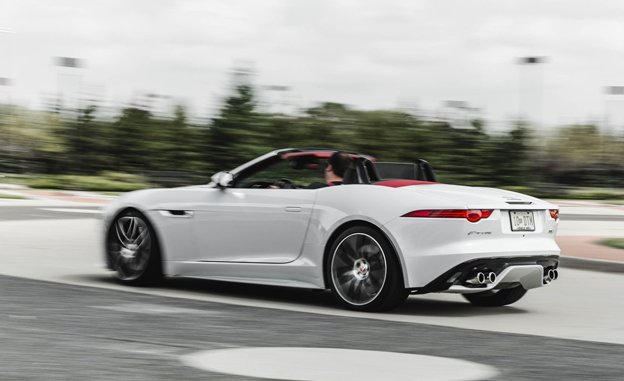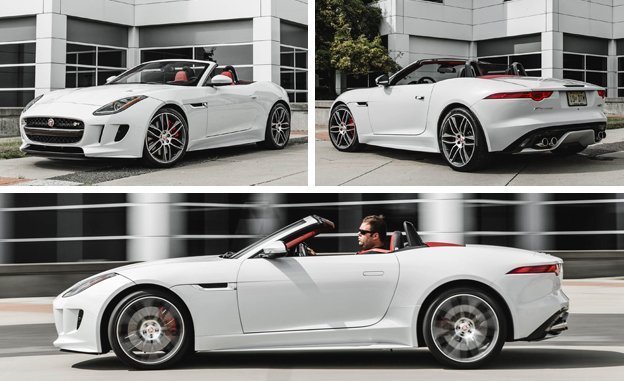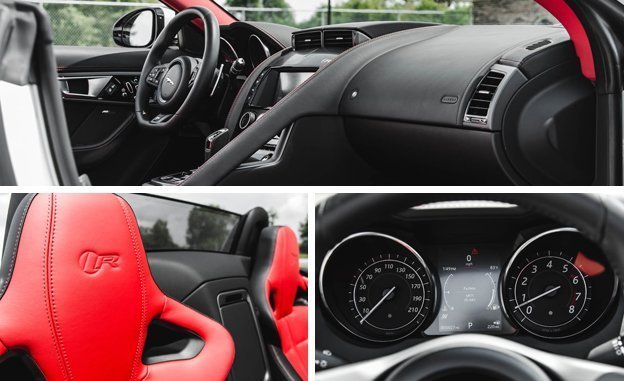
 Instrumented Test
Instrumented Test
Like its coupe counterpart, the R version of the Jaguar F-type convertible raises a question: When is a hot car with sexy good looks, loads of thrust, and gunfighter reflexes a supercar?
Our semiofficial position on this burning question is that a car merits supercar status when it combines exceptional performance with exotic looks, limited availability, and uninhibited style. The Jaguar F-type R is parked just outside that paddock.


So what’s the problem? For one, there are lesser versions of the F-type rolling around out there, with a V-6 engine. You don’t see any entry-level editions of the McLaren P1 or, a little closer to earth, the Ferrari 488GTB.
And in terms of performance, the F-type R isn’t quite on the same level as some of its slightly more glamorous supercar rivals. In a recent comparison test, for example, the Mercedes-AMG GT S bested the F-type R coupe in almost every objective performance category. Then again, full-on supercars are more expensive than this Jag. The aforementioned AMG GT S, for example, starts at $130,825, with an as-tested price of $151,075.
By contrast, the starting figure for the F-type R droptop is $107,445, with options raising the ante to $113,545 on our test car. Even though cars of this kind are for folks with significant bundles of disposable income to apply to their automotive self-indulgence, you don’t need a calculator to understand that these dollar distinctions are significant.
Classifications notwithstanding, it’s interesting to note that the ragtop F-type R delivers performance that is identical to the stats posted by the coupe in the aforementioned comparison test. That’s probably because the curb weights of that coupe and this convertible are within 13 pounds of each other—in fact, the coupe is the heavier of the two.
What this tells us is that Jaguar didn’t have to add extensive gussets or bracing to the convertible to compensate for structural rigidity lost by removing the top. It also tells us that the F-type is a little on the pudgy side. Furthermore, a pretty high proportion of its mass is biased to the front—almost 54 percent, unusual for a design that’s rear-drive based. That front weight bias, and all-wheel drive, probably contributes to the Jag’s mild understeer when pushed to its limits.


But the F-type’s limits are way up there, with 0.98 g of lateral grip. The combination of a stiff structure, firm suspension tuning, torque vectoring, and sticky Pirelli P Zero rubber give the Jaguar the grip of a bat clinging to a wall. However, we also found the car a little unpredictable on the skidpad, thanks to the rear-biased all-wheel-drive system, which allows a little power-on oversteer at first before apportioning some of the power to the front wheels, to rein things in. Despite that, all of the foregoing, plus one of the most accurate and informative electric power steering setups out there, inspires huge confidence at the wheel.
The tremendous grip leads to a different kind of problem, one that’s common to all cars in this rarefied performance category. Exploring the heady limits of this car’s cornering capabilities on public roads requires speeds that are guaranteed to provoke disapproval by badge-wearers driving vehicles with red and blue light racks. Not to mention local citizens who might show up at your home with torches and pitchforks, angry about the F-type’s exhaust, which they’ve likely mistaken for errant gunfire.
But the sound issuing from the exhaust system when the driver calls for full speed ahead is intoxicating. (As it is at startup—few can ignore the V-8’s bark when it lights off.) Find a straight stretch of highway, preferably deserted, drop the top (one switch handles everything), and tramp on the loud pedal, and you can imagine yourself conning a D-type Jag down the Mulsanne straight en route to victory at the 1955 Le Mans 24-hour race.
Okay, the F-type lacks the D-type’s outrageous jet-age dorsal fin. On the other hand, the F-type certainly is no wallflower, and its brakes make the D’s binders seem like something out of The Flintstones. We were a little disappointed that the ragtop’s stopping distance from 70 mph didn’t match the coupe’s 137-foot number, but 149 feet is hardly feeble, and the fade-free repeatability factor is race-worthy.
The eight-speed automatic transmission is another strong point. While we always like to see a manual-transmission option, particularly in a sports car (one is available in the F-type, but not with all-wheel drive or the V-8), this automatic hammers gearchanges far faster than you could move a manual lever through the gates.


We can’t say we’re crazy about the F-type’s fussy, electronic shift lever, but it’s one of those things that probably would become transparent to an owner over time. The rest of the interior is form-fitting, handsome, and beautifully appointed. If there’s any gripe it’s rather high interior noise levels at freeway speeds with the top up—beyond just the exhaust note—rendering the Meridian audio system more or less irrelevant.
But the bottom line here is a convertible sports car that delivers exceptional performance and a big dose of cachet at a price that seems almost to be a bargain by supercar standards. Uh-oh, that word again. Does it apply here? Well, if the Jag F-type R convertible doesn’t quite qualify as a supercar, it is unquestionably a super car.